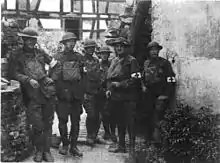William F. Lorenz | |
|---|---|
| Born | February 15, 1882 |
| Died | February 19, 1958 (age 76) |
| Nationality | American |
| Citizenship | US |
| Alma mater | New York University School of Medicine |
| Known for | Research in neurology and psychiatry; Meritorious Military Service in World War I |
| Awards | U.S. Army Distinguished Service Medal |
| Scientific career | |
| Fields | Psychiatry & Psychopharmacology |
| Institutions | University of Wisconsin–Madison |
| Academic advisors | Adolf Meyer |
William F. Lorenz (February 15, 1882 – February 19, 1958) was a Major (O4) in the United States Army Medical Corps during World War I. He was awarded the Army Distinguished Service Medal for his combat actions in France, and had previously served a tour of duty during the Spanish–American War in 1898. Lorenz was also a prominent faculty member at the University of Wisconsin Medical School in Madison, Wisconsin, in the department of Neuropsychiatry. He remained in the U.S. Army National Guard after his service in Europe, attaining the rank of Lieutenant Colonel (O5).


Distinguished Service Medal citation
His governmental citation from 1918 reads as follows:
- The President of the United States of America, authorized by Act of Congress, July 9, 1918, takes pleasure in presenting the Army Distinguished Service Medal to Major (Medical Corps) William F. Lorenz, United States Army, for exceptionally meritorious and distinguished services to the Government of the United States, in a duty of great responsibility during World War I. As Commanding Officer of Field Hospital No. 127, and while in personal charge of the Triage (sorting station for wounded) of the 32d Division during the combat activities of that Division on the Marne, Oise-Aisne, and in the Meuse-Argonne, Major Lorenz so displayed indefatigable zeal and exceptionally good judgment in sorting, caring for, and evacuating thousands of wounded as to directly result in the saving of many lives.[1]
Background
Lorenz was born in Brooklyn, New York in 1882,[2] and received his M.D. from New York University School of Medicine in 1903.[2] He took postgraduate training in neuropsychiatry at the Manhattan State Hospital in New York, and completed a fellowship in that discipline with Adolf Meyer in Illinois from 1908 to 1910. Lorenz joined the faculty in the department of neuropsychiatry at the University of Wisconsin Medical School in Madison, Wisconsin in 1910, and remained there for the rest of his career, except for a two-year leave of absence to serve in the military during World War I.[2][3] He was a professor of Neuropsychiatry and chief of the Wisconsin Psychiatric Institute in the late 1920s and 1930s. Lorenz is credited, along with William Bleckwenn, with developing the technique of sodium amytal-mediated disinhibition ("narcosynthesis" or "narcoanalysis"), which allowed psychiatrists to probe the minds of psychotic patients for diagnostic information.[3][4] Along with colleagues, he also developed a relatively effective treatment for neurosyphilis using an arsenic compound called tryparsamide.[5] Lorenz collaborated with physiologists and pharmacologists on methods to break catatonic mutism; these studies, which were sporadically but dramatically successful, used dilute intravenous solutions of sodium cyanide and the inhalation of carbon dioxide.[6][7]
Personal life
Lorenz and his first wife, Ada, had five sons: William F. Lorenz, Jr., Adrian, Thomas, Paul, and Joseph. Adrian Lorenz died as an infant in 1916, and his wife died in 1942. William Lorenz, Sr. remarried (to Marvel Lorenz) in 1946. He retired from active medical practice in 1952[8] and died of heart disease in Madison, Wisconsin in February 1958.[2][3][8]
References
- ↑ "Valor awards for William Lorenz" Military Times
- 1 2 3 4 "Dr. William F. Lorenz, Famed Psychiatric Leader, Dies Here". Wisconsin State Journal. February 19, 1958. p. 1. Retrieved June 27, 2019 – via Newspapers.com.

- 1 2 3 Clark PF: The University of Wisconsin Medical School: A Chronicle, 1848–1948. University of Wisconsin Press, Madison, Wis.: 1967, pp. 124–131. ISBN 0-299-04350-9
- ↑ Hansotia P, Reynolds NC Jr: "The history of neurology in Wisconsin: the early years, 1907–1957", Wis Med J 2004; 103: 37–41.
- ↑ Lorenz WF, Loevenhart AS, Bleckwenn WJ, Hodges FJ: "The therapeutic use of tryparsamide in neurosyphilis", JAMA 1923; 81: 1497–1502.
- ↑ Loevenhart AS, Lorenz WF, Martin HG, Malone JY: "Stimulation of the respiration by sodium cyanide and its clinical application", Arch Intern Med 1918; 21: 109–129.
- ↑ Loevenhart AS, Lorenz WF, Waters RM: "Cerebral stimulation", JAMA 1929; 92: 880–883.
- 1 2 "Dr. William Lorenz Dies of Heart Ailment". Marshfield News-Herald. February 19, 1958. p. 8. Retrieved June 26, 2019 – via Newspapers.com.
